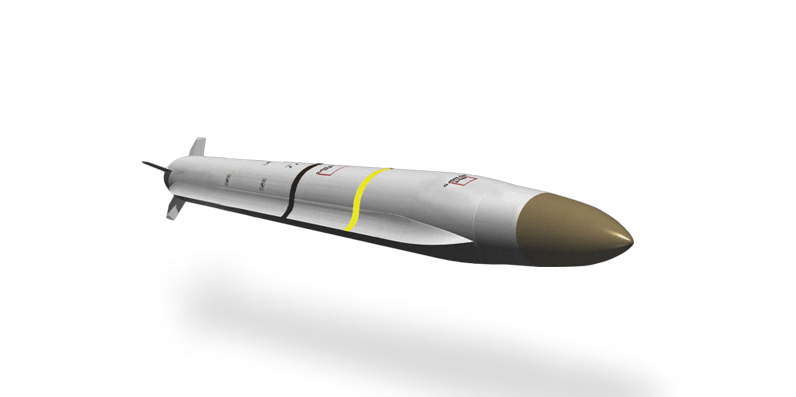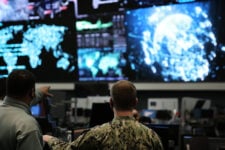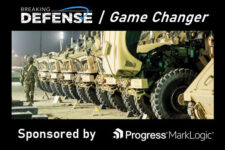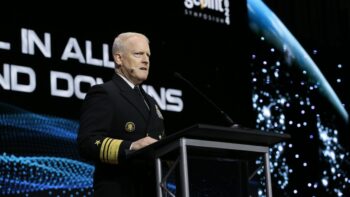
Northrop Grumman’s foundational digital capability developed on complex programs like B-21 and Sentinel are being applied to hundreds of other programs. (Northrop Grumman photo).
In this Q&A with Jeremy Knupp, the executive leading Northrop Grumman’s enterprise Digital Transformation, we discuss: the importance of establishing a common digital ecosystem that allows for collaborative data sharing between employees, customers and partners; how advanced technologies are enhancing work processes; and how connecting data, people, processes and tools is driving improved performance and productivity.
Breaking Defense: What are digital engineering lessons learned from the B-21 Raider program that apply to other programs?

Jeremy Knupp is the executive leading Northrop Grumman’s enterprise Digital Transformation. (Northrop Grumman photo)
Knupp: Digital transformation is not program to program for us, it’s a full enterprise-wide imperative. We’re taking lessons learned from our digital expertise on highly complex programs like B-21 and Sentinel where we’ve established the foundational digital capability and applying that to hundreds of other programs.
Northrop Grumman is executing a first-of-its-kind digital weapons acquisition and development program for the U.S. Air Force with the Stand-in Attack Weapon (SiAW). Due to our digital development processes, we expect to meet the U.S. Air Force’s Initial Operational Capability (IOC) target date for this advanced weapon in 2026.
We’re seeing the same in our Space business. Space is becoming a highly disaggregated distributed series of systems that aren’t just solved by a single platform. We are continuously evolving a common digital ecosystem so that people within our company and our customer space can move around, work in different domains, and carry the same kind of capabilities forward.
For us, a program digital ecosystem is about knowledge parity with our customers and transparency to accelerate the flow of information and pace of decisions in a disciplined approach. Our digital ecosystem connects our employees, customers and partners and enables efficiency across all programs. This gives us a force multiplier in our ability to make data-driven decisions with insights like never before.
Harnessing the learnings of B-21 and Sentinel, we have begun integrating hundreds of programs into a mature, digital ecosystem that makes it possible for us to deliver the capability our customers need — when they need it.
Breaking Defense: Let’s break down the entirety of the digital lifecycle thread. How does digital development improve the thread from beginning to end?
Knupp: Digital engineering is the epicenter of the digital thread. We are applying digital practices throughout the full program lifecycle — design, engineering, manufacturing, supply chain, production, sustainment — developing all aspects of the program from day one. This is driving efficiency over the long term, taking sustainment into account upfront, especially during the digital design phase, yielding near-term benefits. The harmonization of data and processes from disparate systems to a single source of truth for digital development and operations is revolutionary, resulting in efficiencies that can and will accelerate the traditional program lifecycle.
For example, as model fidelity and confidence increase, prototypes won’t be necessary. Thus, the first airplane to exit our facility is a production-representative test aircraft, not a prototype.

In a first-of-its-kind digital weapons acquisition and development program for the U.S. Air Force, Northrop Grumman expects to meet the Initial Operational Capability target date for the Stand-in Attack Weapon in 2026. (Northrop Grumman photo)
Breaking Defense: It’s interesting that you’ve brought the supply chain into this discussion of the digital thread in engineering.
Knupp: When you think about the real value of the digital thread, it’s the increase in visibility and collaboration. Our suppliers are critical partners in our mission to deliver next-generation technology solutions with quality and speed. It is more important than ever that what we design links directly with our suppliers, as well as our customers. The digital thread enables real-time collaboration between our teams, customers and suppliers. It’s making us faster and setting our suppliers up for success. By connecting them into our digital ecosystem we’re lowering supplier costs and significantly improving productivity.
The digital thread allows a simplified workflow with our suppliers. Now, we’re all reading off the same sheet of music. We can make changes in real time, with more data upfront so that we can not only catch a glitch earlier, but we can also make sure it doesn’t impact the supply chain. The ability to get rid of the go-backs is one of the first major places where we’re already seeing benefits in reduced cost and increased speed of delivery.
We are digitally connecting our supply chain operations to design, build, test and collaborate with our partners from a single source of truth. This is accelerating operations and increasing quality and speed of delivery to our customers. Over the next few years, we expect to have most of our supply base fully integrated into our ecosystem.
Breaking Defense: What’s the role of AR/VR in the digital engineering environment?
Knupp: The AR/VR work we’re doing is changing how our employees operate, providing meaningful benefit to our customers, and is very real – the impact is significant and felt in our business operations. We’re able to overlay digital content onto the user’s view of the real-world, so that complex design can be optimized in the affordable comfort of the digital environment before ever being built and installed.
On the production line, we’re delivering greater efficiency and precision by using commercially available AR/VR. We’re incorporating AR/VR into our processes and it’s improving first-time quality and leading to enhanced customer confidence. For example, on the B-21, we’ve realized over 15 percent labor efficiencies in one area of the build due to the use of the digital thread tied to advanced manufacturing technologies.
Learn more about Northrop Grumman’s digital ecosystem at: Digital Transformation | Northrop Grumman.























